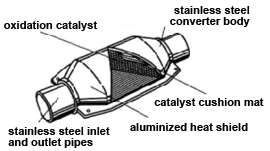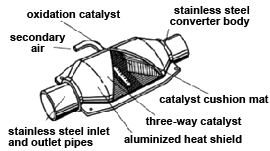Since the 1950's, automotive manufacturers have been trying to reduce the amount of polluting chemicals produced by internal combustion engines. It wasn't until the middle 1960's that we saw emission control devices first installed on passenger cars. As the 1970's began to roll by, automobiles were continually modified so that they would satisfy increasingly stringent federal emission level limits.
In the early years of emission control systems, auto manufacturers focused their efforts on modifications designed to produce a cleaner running automobile. Unfortunately, most of these modifications resulted in decreased vehicle power, decreased fuel efficiency, and an overall deterioration of engine driveability characteristics.
Because of the fact that early model emission control devices made cars run cleaner at the expense of everything else, most of North America's drivers developed a very hostile attitude toward emission control devices. In fact, during the middle seventies, disabling and/or removing emission control devices became a widespread and profitable business; people felt that if they could do away with their vehicle's emission control components, the car would run more like their earlier cars. The truth is, however, that most cars run worse when the emission control devices are disabled.
In the midst of this unfavorable climate, catalytic converters were introduced. As you can probably imagine, the introduction of a new emission control device that required the use of the new, (and at that time, more expensive) "unleaded" fuel didn't do much to help the popularity of the converter. On top of that, many consumer advocate groups claimed that catalytic converters were a fire hazard. Other people complained that converters substantially reduced the fuel efficiency of the car.
The unfortunate twist to this whole story is that in almost every case, the negative claims against converters were not really true. The fact is, catalytic converters were, and still are, the best means of reducing engine pollutants. The catalytic converter reduces engine pollutants more efficiently than any other emission control device on the car, and does so in a way that barely affects the power of the engine or the fuel economy of the vehicle. In no way do converters hinder the desirable driveability characteristics of a car, and the concern about converters causing fires never became a problem.
Early in converter history people replaced their catalytic converters with substitute test pipes. It's only been within the last few years that emission testing programs, mandatory vehicle inspections, and EPA enforcement of tampering laws have slowed the removal of catalytic converters and other emission control equipment. In fact, today, many aftermarket catalytic converters are sold to consumers who at one time removed their original equipment converter.
Converter TypesAs you may already know, there are three types of catalytic converters
For the most part, each of these different converters came about because the EPA stiffened the regulations that govern the amount of pollutants that come from a new car. Here's a quick summary of the events that spawned our three different types of catalytic converters.
In 1975, the EPA stiffened the regulations that limit the amount of carbon monoxide (CO) and hydrocarbons (HC) produced by new cars. As a result of the stiffer regulations, auto manufacturers began using oxidation catalytic converters.
In 1979, the EPA stiffened the regulations that limit the amount of oxides of nitrogen (NOx) produced by new cars. As a result of the stiffer regulations, auto manufacturers began using three-way-plus-oxidation converters on most applications.
In 1981, the EPA again stiffened the regulations that limit the amount of oxides of nitrogen (NOx) produced by new cars. As a result of the stiffer regulations, auto manufacturers began using the reduction, or three-way catalytic converter on many applications.
How Do Converters Work?
Within the stainless steel shell of an aftermarket catalytic converter lies a substrate that's coated with a combination of platinum, palladium, and sometimes rhodium. These three chemicals are frequently called precious, or noble, metals. Typically, oxidation converters are loaded with platinum and palladium. Three-way and three-way-plus converters are loaded with platinum, palladium, and rhodium.

Hot exhaust gases containing the pollutants, carbon monoxide, oxides of nitrogen and hydrocarbons, travel through the exhaust pipe and eventually come in contact with the precious metals that are loaded on the converter's substrate. The substrate is a honeycomb of small ceramic passageways.
When the exhaust gas comes in contact with the precious metals or catalyst, a chemical reaction takes place that weakens the bonds of the polluting chemicals and allows them to easily convert into the more desirable by-products of combustion, which were discussed earlier.

2-way converters were first introduced in the mid 1970's. They oxidize hydrocarbon and carbon monoxide emissions only. The name 2-way refers to the number of pollutants affected by the converter.

In this design, exhaust gases are directed to flow over the substrate where they come in contact with the catalyst. The exhaust gases increase in temperature and continue to oxidize. Hydrocarbon (HC) and carbon monoxide (CO) emissions are converted into water (H2O) and carbon dioxide (CO2) before they enter the muffler.
Because of the intense heat created by this process, exhaust gases leaving the converter should be hotter than the gasses entering the converter. This also explains why heat shields are required on most units.
3-way without air converters were introduced in the late 70's. These converters reduce NOx emissions as well as oxidize hydrocarbon and carbon monoxide.

Inside, a 3-way without air converter looks like a 2-way converter. But, the 3-way without air substrate is coated with rhodium and palladium.
If an engine's exhaust is high in hydrocarbons and carbon monoxide, an air pump and tube feed extra oxygen directly to the converter. Inside a 3-way with air-injection, there are two substrates.

The front chamber is coated with rhodium and palladium. Rhodium reduces NOx emissions into simple nitrogen (N2) and oxygen (O2). This process is most effective when there's little oxygen present. That's why this substrate is located upstream of the air tube inlet.
A second substrate of palladium and platinum is located downstream of the air inlet, so the increased oxygen enhances the oxidation of hydrocarbons and carbon monoxide.
Converter Failure
No matter what the converter design, they all fail for the same reasons. Since there are no moving parts in a converter, the most common cause of failure is contamination.
When overly rich fuel mixtures or raw fuel is introduced into a converter, its temperature can rise to the point that its substrate will simply meltdown. This is known as thermal failure. Thermal failure will deactivate the catalyst and, in extreme cases, block exhaust flow through the unit.
Thermal Shock
This occurs when an overheated converter is fed cold raw fuel or comes in contact with winter elements. The ceramic substrate cools too rapidly and contracts unevenly. It starts to crack and break up. Normal exhaust system vibration will cause it to disintegrate even further.
Silicone that has leaked into the exhaust from antifreeze or sealants will similarly coat the catalysts, with the same result - a non-functioning converter. In cases of serious contamination or meltdown, the converter needs to be replaced.
Obviously, restrictions of any kind - inside the converter or elsewhere in the exhaust system - will also affect converter performance. If the restriction is internal, the converter needs to be replaced.
Converters can also sustain physical damage. Body punctures or weld cracks create leaks that require converter replacement.
Under Federal EPA regulation, replacement of original catalytic converters is allowed only if the original converter(s) is missing, or the vehicle has more than 50,000 miles or is at least five years old and the need for a replacement has been established and documented, or a local inspection program has determined the existing converter is in need of replacement.











